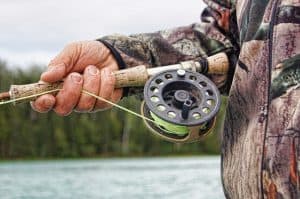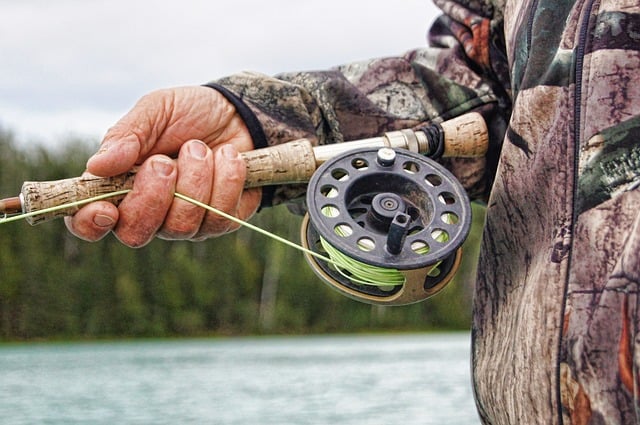 To say “conventional” fishing and fly fishing are different goes well beyond the realm of understatement. My first experience with fly fishing came in Alaska, when reading A River Runs Through It for an outdoor literature class. One of my favorite professors was obsessed with fly fishing and brought his rod to have everyone learn how to cast, chasing that perfect S-shape strike. Understanding fly fishing meant we could understand the story better.
To say “conventional” fishing and fly fishing are different goes well beyond the realm of understatement. My first experience with fly fishing came in Alaska, when reading A River Runs Through It for an outdoor literature class. One of my favorite professors was obsessed with fly fishing and brought his rod to have everyone learn how to cast, chasing that perfect S-shape strike. Understanding fly fishing meant we could understand the story better.
Even in fly fishing, there are two main types of flies (sometimes outdoorsmen use the spelling “flys” when dealing with fly fishing lures): Wet flies and dry flies. So which is better? Which should you use?
The main difference between a wet fly vs a dry fly is that a wet fly is designed to go beneath the surface of the water as it mimics insects that look like insects that are below the water’s surface while a dry fly represents insects that live out of the water, but land on it from time to time. Both styles of fly fishing fly can be very effective through the dry fly is the most common or traditional fly design.
So why are there two styles of flies and when should you use one as opposed to the other? Read on for an in-depth understanding of wet flies, dry flies, and the biggest obvious differences between the two
Table of Contents
The Short List of Wet Fly vs. Dry Fly Differences
- The wet fly goes a little bit under water, the dry fly floats on the surface
- Wet flies will resemble hatching flies, emerging bugs, and even small hatchlings or baitfish just below the surface while dry flies resemble full-grown insects, flies, or even small rodents
- Wet flies are a little bit easier to cast and more forgiving of poor casts than dry flies are
- Wet flies tend to be a little bit larger than dry flies, though that’s not true 100% of the time
Notable Differences Between Wet Flies and Dry Flies
Dry flies are so lightweight that they can float or land on the water surface softly. They look like terrestrial or aquatic insects. That is why fly fishers often consider dry flies as quick bait. Dry flies are mostly available in freshwater because you don’t find too many bugs or pests in saltwater areas.
These are also often referred to as “traditional flies” or “basic flies.” They have traditionally been the most common style of lure for the fly fisherman however wet flies are increasing in popularity in many areas.
You need to use a floating line with a tapered leader. Attach the fly at the end of the leader so that it will float gently on the water. Some of the most common dry flies I use during fly fishing are the Royal Wulff or Mayfly, the Elk Hair Caddis, or the Parachute Adams. Apart from these basic materials, you will also require feathers of marabou, peacocks, pheasants, and fur. The bait should consist of the dry fly and something lightweight, allowing it to float easily.
Dry flies look as if an insect has just fallen on the surface of the water. This attracts the attention of the fishes nearby almost instantly. Anglers often choose to dry fly fish during seasons when there are plenty of insects around.
Wet Flies Are a Bit Different
Wet flies look like insects that exist underwater. They flow in the water, depending on its current. Some of these flies can go down as far as your line goes. Wet flies are heavier because they have to stay underwater for long periods. I use bead heads or copper wire to ensure that the wet flies stay underneath. The weight of the flies, along with the weight of the copper wire allows the bait to stay submerged so that the nearby fishes can fall for the trap.
Choosing the right bait or in this case, choosing the right fly is crucial for fly fishing. If you are new to fly fishing, learn this trick from day one. I learned it late. That’s why I couldn’t catch a lot of fish during my first few attempts. There are two types of flies that you will use: wet flies and dry flies. It is essential to understand the difference between the two so that you can enjoy your first catch quickly.
The most notable difference between these two flies is their size. Dry flies usually have a size of 12 and smaller. On the other hand, wet flies have size 10 and larger. There is another difference between these two baits and that’s weight.
Dry flies are lightweight. They can float on the surface of the water as if an insect has fallen suddenly. Wet flies are heavier. They usually remain under the water and can reach deep down, depending on how far your fishing line can go.
Fly Fishing Considerations
Apart from their size and weight, anglers use these flies during different seasons, locations, and weather conditions. You need to judge the water’s surface and understand the current before selecting one of the flies. After months of practice, I can now understand the feeding habits of the fishes in a specific area by checking the water current. If you don’t have any luck catching fishes with dry flies, it means that the population feeds underwater.
I used to take both types of flies during my initial expeditions. You can follow the same method until you start understanding the water’s surface and current. Even if it is a small lake or river, the type of fly you select will increase your chances of catching fishes successfully.
I cannot describe the joy I get from fly fishing. Some days I return empty-handed. But, the overall experience is awesome. Once you understand how to feed dry and wet flies, depending on the water’s surface, it won’t take a long time before you become a pro like me.
In Conclusion
Fly fishing can be a little bit intimidating at first, but this is one of those practices that is incredibly rewarding and opens up an entire world of crafting your own flies, hitting those out of the way trout streams, and enjoying fishing in an entirely different way. While it might not be for everyone, there’s no reason to let it intimidate you.
The fly fishing community is a strong and open one, and before too long you’ll not only fully understand the differences between a wet fly and a dry fly but you will have your favorite types of each kind!

